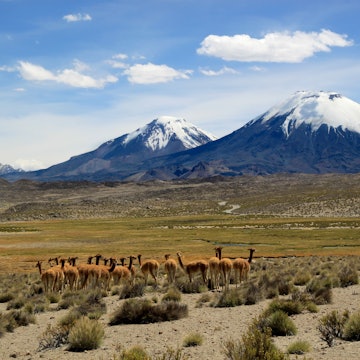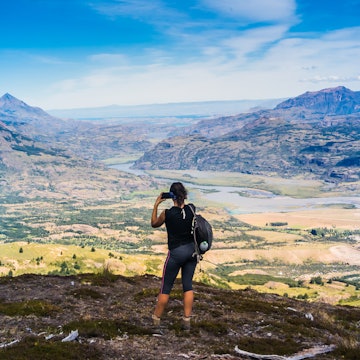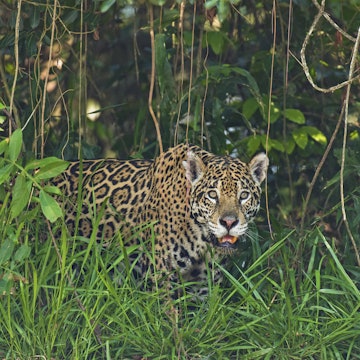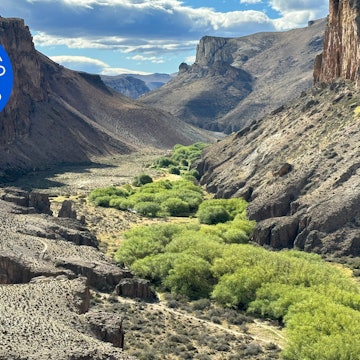
Lonely Plan-it: how to organize a hike on Chile’s famous W Trek in 2023

Jan 14, 2023 • 8 min read

Tackling the W Trek in Chile’s Parque Nacional Torres del Paine is a challenge and a thrill © sharptoyou / Shutterstock
In this series, we take you step by step through how we planned some of the most complicated travel adventures, so you can recreate them yourself with ease. Here, writer Sarah Reid takes you through how she planned her hike on Chile’s famous W Trek.
Tracing the foothills of the snow-capped Paine Massif in southern Chile’s famous Parque Nacional Torres del Paine, the W Trek one of the world’s most epic multi-day tramps. Named for the shape sketched by the 80km (50-mile) trail, the W Trek immerses you in some of Patagonia’s most mesmerizing scenery, with turquoise lakes, oozing glaciers, gnarled subpolar forests and wildlife spotting opportunities aplenty (you might even spot a puma).
While it’s easy to follow the well-trodden if not always well-marked trail, planning the expedition is complicated by the numerous ways to access the route and the multiple reservations required before you set out. Having recently experienced the trail in two different ways, I’ve figured out all the tricks you’ll need to plan one of the most memorable hikes of your life. Here’s what I learned.
Step 1: Time it right
Find the best mix of good weather and accommodation availability.
Hiking the W Trek hinges on the availability of the half-dozen currently operational refugios (hostels with limited dorm beds, a restaurant, hot showers and campsites) dotted along the route, which can book out months in advance during the November-to-February peak season. This is the warmest time of the year comes with the added bonus of long daylight hours – but it can also be very windy. The less-busy shoulder seasons (March to April and September to October) offer increased camping availability and more agreeable weather (potentially; this is Patagonia, after all). A guide is required for a wintertime hike (May to August, when refugios are closed). Wildlife, including pumas, can be spotted year-round.
To get to Torres del Paine, you’ll need to travel to the small, beautifully situated gateway city of Puerto Natales. You can fly here (or to nearby Punta Arenas) from Santiago, take a four-day ferry trip from Puerto Montt or travel overland from Argentina (a 5.5-hour bus ride from El Calafate to Puerto Natales). From Puerto Natales, expect a two-hour bus ride to the eastern end of the W Trek, and a three-hour bus ride followed by a 45-minute ferry to the western end.

Step 2: Decide which direction to hike in
You can start or finish your trek with one of the hike’s most epic views.
The W Trek can be hiked from east to west or vice versa, independently or guided, and you can take as many days as you like (pending refugio availability). Hikers with a good level of fitness will find it’s an achievable four-day independent hike. Factor in an extra day to add a glacier kayaking or ice-trekking excursion departing from Refugio Grey (arrange in advance; more on this below).
The benefits of hiking east to west include frequent daily bus services from Puerto Natales (from 7am) to the trailhead. You’ll also knock off the challenging hike to Mirador las Torres, at the base of the three granite towers that give the national park its name, on the first day. Hiking in this direction also means you don’t have to worry about securing a spot on the first ferry of the day across Lago Pehoé to access the western end of the W (critical for a four-day itinerary), as ferry tickets can’t be booked in advance. The early ferry (9am) only operates from November to March.
The beauty of hiking west to east is the opportunity to spend your last night at Refugio Chileno, making it easier to catch the sunrise at Mirador Las Torres on your final day and be back in Puerto Natales by dinnertime (finishing at Paine Grande gets you back to town closer to 10pm). With Patagonia known for its strong westerlies, hiking eastward also keeps the wind at your back for most of the journey.
Step 3: Consider your booking options
Reserve your accommodation, transit and park pass in advance to simplify your life.
This is where it gets tricky. The two refugios at the trail’s western end (Paine Grande and Grey) are operated by Vertice Patagonia, which also runs glacier trekking and kayaking tours. The other four refugios (Francés, Cuernos, Chileno and Central; there’s an additional bunkhouse near Central called Torre Norte) are operated by Las Torres Patagonia. You can book preferred campsites and dorm beds (some refugios also have rooms) separately through their websites, or make reservations at camps run by both operators in a single booking via Booking Patagonia.
Meals, pre-pitched tents, sleeping bags and mats can be prebooked for additional fees, pushing the cost of a four-day hike from as little as $62 (camping costs only; wild camping is forbidden) to around $400 if you book all the extras (and it’s worth doing so if you’re not keen on carrying all your supplies, including cooking equipment). Booking bus tickets to and from Puerto Natales in advance is also recommended; Bus Sur services both ends of the trail.
An easier if more expensive option is to book an all-inclusive package. These come in all shapes and sizes, ranging from classic unguided through-hikes, to hikes along sections of the trail each day with a guide then shuttling back to an off-trail camp or lodge each night. (Note that it’s difficult to complete all legs of the W Trek as day hikes given the volume of backtracking required to the two exit points.) Local operators offering good-value unguided through-hike packages with an east-west itinerary (about $1000) include Chile Nativo and ChileTour Patagonia. Las Torres Patagonia and Vertice Patagonia also offer packages with accommodation at their own properties (a through-hike is only possible with the former). International operators including G Adventures and World Expeditions also offer through-hike packages.
You’ll also need to book a multi-day national park pass via the CONAF website ($35), which will be checked at the entrance to the park.

Step 4: Prep for the adventure
Find the perfect gear for your adventure.
With the entire trail located between 100-900m (330-2600ft) above sea level, there’s no altitude to factor in on the W Trek. But it’s the ever-changing Patagonian weather, along with the uneven, often-exposed trail, that will likely test you. Layers are key, and a waterproof jacket, rain pants and pack cover are essential year-round.
Expect to have next-to-no cellular reception throughout the journey. Wi-fi coupons are available for sale at refugios (provided the router is working) but it’s more fun to stay disconnected and mingle with fellow hikers at the bar instead; every refugio has one. Be mindful when packing that everything you carry into the national park must come out with you – the only rubbish bins at refugios are designed for toilet paper. With a limited number of power points in refugios for charging devices, packing spare batteries is a good idea.
Step 5: Nail the trail
Be adaptable to conditions to get the most out of your journey.
Days on the trail can be long on a four-day hike; set out by 8am in autumn and spring to arrive in camp well before nightfall. If you’ve booked meals, most refugios have two sittings; book the first sitting when you arrive in camp each day to ensure an early night, and early start the next morning.
On foggy days, reconsider rising early to hike to Mirador las Torres for sunrise. You might also wish to reassess the mostly uphill return hike from Mirador Francés to Mirador Británico (the middle arm of the “W”) in poor weather, though I hiked the latter in average conditions and enjoyed it, particularly as I spotted a pair of endangered huemul deer right below Mirador Británico. Consider leaving non-essentials in a dry bag at Italiano (a CONAF-run camp not currently open for overnight stays) on your way up, as you’ll pass this camp again on your way back down.
If you’re making good time between Paine Grande and Valle Francés (French Valley), consider veering off the main path to hike the lesser-tramped alternative trail around the slightly more scenic eastern side of Lago Skottsberg, which adds about 30 minutes to the trip. Turn left at the first bridge after Italiano if you’re coming from the east, and head right at the fork after the first bridge you cross if you’re coming from Paine Grande.

If I could do it all again…
I booked a last-minute four-day through-hike package on my first W Trek experience. I hiked east to west in March 2022, and camped at Central, Cuernos and Paine Grande, and this itinerary was perfect for me. I’ve since hiked sections of the trail on a guided multi-day, multi-sport tour with Chile Nativo, with superb perspectives on Torres del Paine that complemented my first experience.
If I were to do the W Trek again, I’d aim to tackle the extended version of the trail called the O Circuit, ideally in late September, as I found the weather superb and the crowds thin when I visited then. I’d cut costs by making independent bookings, and I’d book my meals again (though extra comforts are not available at all refugios on the O Circuit).
Since my feet were soaking from the second day onward, I’d also wear waterproof boots; pack fewer snacks, as the boxed lunches were sufficient; and go easier on the Carménère (Chilean red wine) at the refugio bars. Did I mention you can order pisco sours, too?















